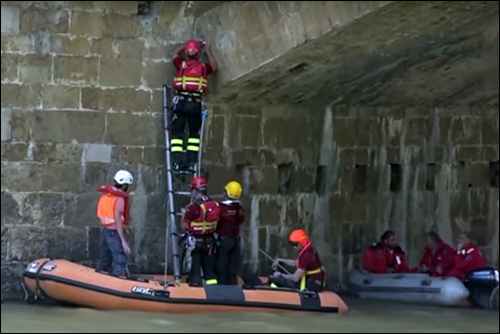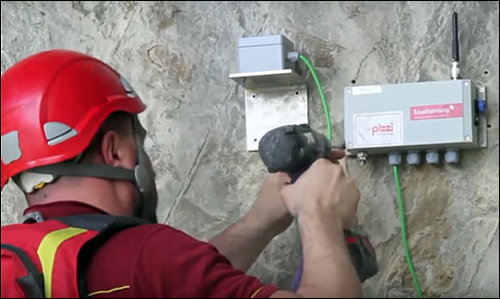In 2016, a sinkhole consumed a row of parked cars 200 meters (656 feet) in length, in the city of Florence, Italy. The depression, located near the Arno River, was caused by underground flooding from a water main break, and it didn’t just put personal property at risk—it also endangered the city’s medieval Ponte Vecchio arch bridge. With the help of technology, the city moved quickly to resolve the problem, filling the hole without causing any potential damage to the World Heritage Monument stone bridge.
The University of Florence and technology integrator Pizzi Instruments employed an Internet of Things (IoT)-based system from Worldsensing to capture real-time data regarding the conditions of the soil around the bridge’s supports, as well as any tilting in the bridge itself, says Albert Zaragoza, Worldsensing’s CTO. Since the six-month project was completed three years ago, the company has brought sensor connectivity solutions to tunnel projects by transmitting data about conditions from underground construction endeavors.

The water main break caused erosion on the bank of the Arno River that could put several buildings and the bridge at risk, and repair work could have had further impact. The Florence City Council, together with the Italian Civil Protection, requested that the University of Florence’s Geology Department manage the project and ensure the safety of the structures around it. Pizzi Instruments would install a network of geotechnical sensors. The latter selected Worldsensing’s Loadsensing solution for wireless collection and data transmission.
Worldsensing has been providing sensor-based data for industries and governments around the world for more than a decade. It deploys construction-monitoring systems, as well as selling its technology for smart cities and mining. In fact, Zaragoza says, the company has 200-plus customers in 60 countries. The firm builds and manages products with local partners that deploy its technology.
In the case of Florence’s sinkhole, the concern was that the process of fixing the leaking water main could put further pressure on the 32-meter (105-foot) bridge’s support system. Additionally, several buildings in the area were occupied and would require immediate evacuation if any strain were detected in building walls.
Sensors can predict a problem by measuring both the conditions in the soil around structures, as well as any strain or tilt of the structures themselves. In a traditional project, one person would manually measure the state of the soil and the position of the walls and piers. However, Zaragoza says, that doesn’t provide real-time data all day, every day. Additionally, cables could not have realistically been installed on the site due to the presence of water, so wireless connectivity was required.

Therefore, the construction team installed numerous Pizzi Instruments tilt and soil sensors connected to a total of eight Worldsensing LoRa nodes, near and on the piers of the Ponte Vecchio, to track bridge stability and integrity, as well as any potential movement of the structure or the buildings around it. “Real-time response around events is key for us,” Zaragoza states.
The Worldsensing nodes can be connected to up to five sensors. The nodes capture the sensor readings related to any change in the tilt of bridge piers or soil chemistry, then transmit that data to a LoRa gateway installed at the site. The gateway captures the data, filters and interprets the details, and forwards that information to a dedicated local server via a cellular connection.
Worldsensing’s network uses InfluxData‘s InfluxDB open-source database to store time-series data on the cloud-based server, as well as create rules and alerts and react to events in real time. “Having a central database to store all the time-series data in a single point is mandatory,” Zaragoza says. Worldsensing’s IT operations team evaluated the impact the technology would have and how it would be used prior to the installation. “It turned out to be the right choice,” he adds, “as we had something up and running very quickly, allowing us to test and validate.”
That collected data was used as input for an early-warning system based on specific thresholds the city project’s technical team had set up, according to Paolo Farina, a co-founder of Geoapp, a spinoff company of the University of Florence that oversaw data analytics. With the data, the team was able to detect how much pressure was being put not only on the bridge but on historic buildings in the area. “From the sensors,” Farina explains, “we were able to understand that the wall was still slowly moving in the first days after its partial collapse, and then it slowed down and became stable.”
“Fortunately, there was no significant movement affecting the stability of the Ponte Vecchio detected during the monitoring project,” Farina states, adding, “The construction works required to stabilize and rebuild the embankment didn’t impact on the monument.” The gateway itself was ruggedized for an outdoor environment, with an IP67 rating so that it could be used in the presence of water.
Worldsensing has also provided its technology in recent years for the Purple Line Rail Link in Washington, D.C., and the Purple Line Extension in Los Angeles, Calif., as well as tunnel monitoring for the Grand Paris Metro project in Paris, France, and the Melbourne metro line extension in Australia, according to Maite Garcia, Worldsensing’s PR manager.
“During all these years, we identified a common problem for all of our customers, which was reacting to events using a siloed approach, each department on its own, trying to analyze their data in isolation,” Zaragoza says. “That requires customization to ensure data being captured is managed, displayed and forwarded as needed for each unique project. We built our real-time platform, not only to react faster to particular events, but also to be able to improve operations and react to anomalies faster.”



